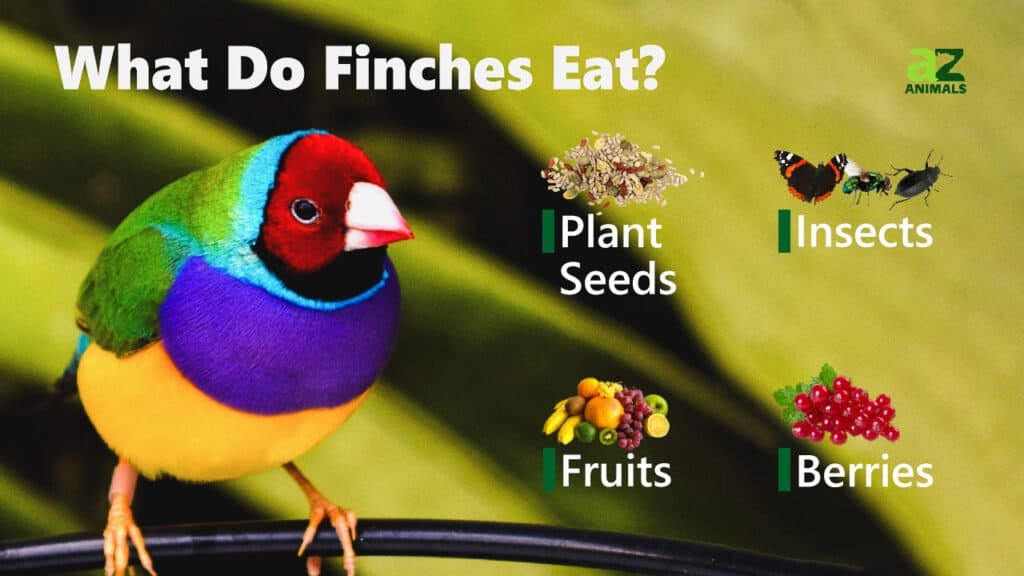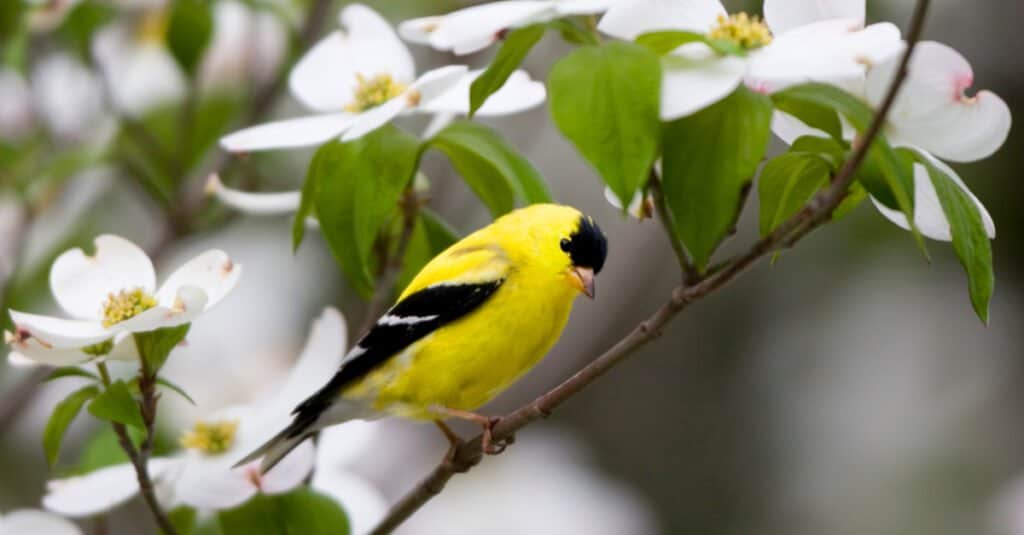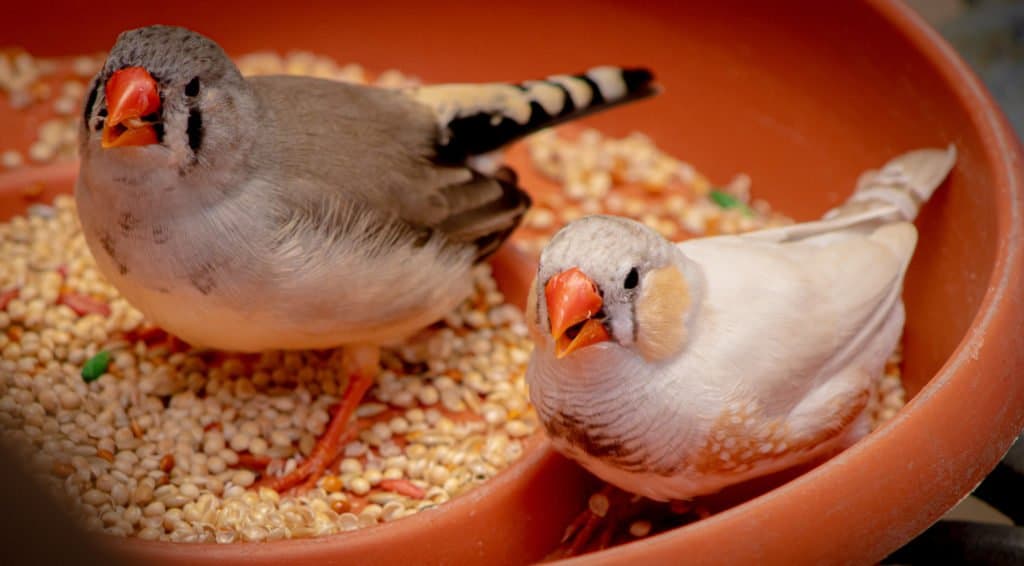Finches are some of the smallest and most common birds across the world, especially in North America. Any bird enthusiast (or really just anyone looking) is sure to see finches congregating around bird feeders in groups. These cute birds range all over the world and have a few features that help scientists group them accurately. The finch family is known as “Fringillidae,” and within that family are multiple subfamilies, genera, and species that are all considered “finches.” Let’s take a look at the diets of these amazing birds and learn: What do finches eat?
What do finches eat?

Finches are such a diverse group of birds that any “list” or “guide” about them would be woefully incomplete. They live in so many environments all around the world, from coasts to mountains and everywhere in between. As a result, each finch has a specialized diet that correlates to its ecological niche. Still, there are some generalities that we can look at and learn about finches.
Finches are generally considered to be granivores, meaning they eat the seeds of plants. In the wild, finches will feed on a huge variety of grains and seeds, changing their diets as the season changes. Some of the common seeds that a finch will eat are sunflower seeds, thistle seeds, and most seeds found within fruit or berries. Additionally, finches eat grains, primarily things like millet, oats, barley, and buckwheat.
During certain times of the year, finches will include foods in their diet as they become available. When there are fruits and vegetables about, it’s likely that a finch will opportunistically feed on them. Berries are often an important dietary element for finches, and they will feast on them seasonally.
For many finches, breeding season means a carnivorous addition to their diets. As they lay eggs and their chicks hatch, finches will switch their diets over to insects to give themselves and their chicks the right nutrients they need as they grow. As the chicks age, however, they will eventually switch back to their seed and grain diet.
A list of the foods finches eat
Here is a list of foods finches eat, but any specific breed will vary by region:
- sunflower seeds
- sunflower hearts
- nyjer
- grass seeds
- millet
- flax seeds
- oats
- barley
- cracked corn
- raisins
- strawberries
- blueberries
- blackberries
- raspberries
- crickets
- ants
- wasps
- beetles
- worms (wax, silk, and white)
- feeder food
- suet
How do finches get their food?

Finches are diurnal, foraging through the day for seeds, nuts, and fruits.
©FotoRequest/Shutterstock.com
Finches have a few ways they get their food. When it comes to grains and seeds, they forage most of the day, hopping along the ground. Most finches are diurnal, meaning they are active and awake during the day, just like a human. A finch will find food throughout the day using its eyesight and occasionally its olfactory senses.
The flight pattern of a finch is common, and they can often be seen flying in a long bobbing motion through the air. They congregate in flocks as they forage, sometimes as many as 50 strong. They are often seen at bird feeders and will return daily when there is a constant source of food. Their foraging habits change through the year as some foods become more available than others.
What kinds of finches are there?

There are over 200 species of “true finch” in the Fringillidae family and even more outside it.
©Danita Delimont/Shutterstock.com
The overarching family, Fringillidae, encompasses a large variety of birds. These birds are known as “true finches.” The different sub-families include grosbeaks, euphonias, canaries, and siskins, as well as a few less commonly known ones. However, outside of the “true finches” are many other birds that are considered finches. Overall, “finch” is a relatively loose term. Altogether, there are 50 genera with over 200 species identified within. Knowing that, let’s take a look at some of the most common, as well as some of the most interesting.
The most common finch in North America is the house finch, a brown bird with a red head and throat, commonly seen at bird feeders and in yards. House finches are colorful to see and to listen to. They are often the most common and reliable feeder birds, with amateur birders often learning to identify them first.
While less common, the American goldfinch is similar in size to the house finch, only yellow, white, and black with a thinner and longer build. They are beautiful to see and often look like flecks of gold as they whizz by. Goldfinches primarily eat the seeds of daisies and also of grasses, weeds, and trees.
The spice finch is an Old World finch of the Estrildidae family. It is native to Asia and has beautiful brown patter across its chest. The spice finch mainly eats grass seeds and occasionally small berries and insects. They are often kept as pets due to their looks.
One of the rarest finches in the world is the mangrove finch. This finch was first discovered by Charles Darwin and contributed to his formulation of the Origin of Species, essentially proving the theory of evolution. The mangrove finch lives on the Galapagos Islands and is critically endangered, likely with less than 100 individuals left. Mangrove finches have specialized diets, eating mostly insects and grubs.
How do I feed finches in my yard?

Finches prefer sunflower and nyjer seeds, especially in a suet feeder.
©Wirestock Creators/Shutterstock.com
Attracting finches is one of the easiest and most rewarding things any amateur birder can do. The easiest way to attract common finches (house finches, goldfinches, and more) is through a birdfeeder or suet feeder. For most finches, a bird feeder filled with black sunflower or nyjer seeds is irresistible since those are their favorite seeds.
Additionally, finches are likely to come to suet feeders in the winter when resources are scarce. Suet feeders are essentially fatty cubes (often made with rendered beef fat or something similar) and packed with seeds and nuts. The suet is nutritional for the birds, and the seeds within present an engaging challenge for them. During the winter, finches are more likely to feed at a suet feeder because of its higher caloric content. Additionally, suet feeders often have capsaicin (ingredient found in hot peppers that makes peppers spicy hot) to deter mammals like squirrels from stealing the foods. Birds can’t feel the spice, so it doesn’t bother them.
The photo featured at the top of this post is © Nataly Studio/Shutterstock.com
Thank you for reading! Have some feedback for us? Contact the AZ Animals editorial team.






